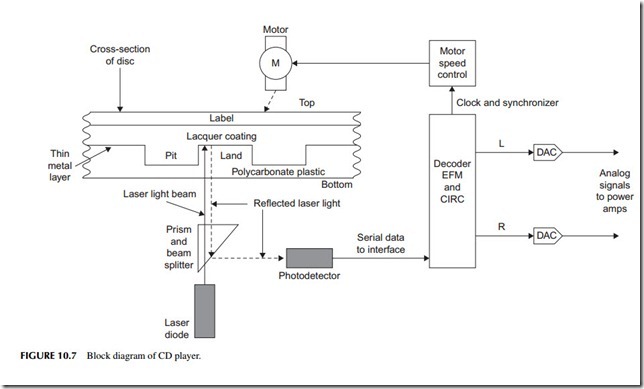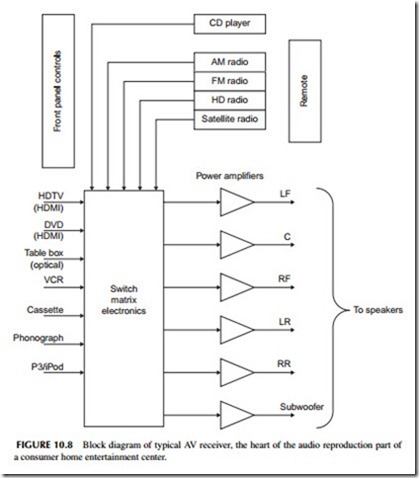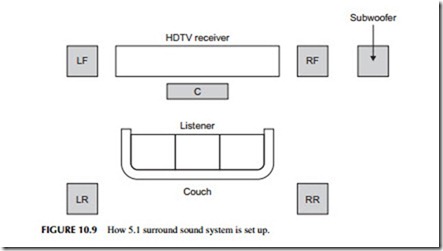AV RECEIVER
An HDTV receiver is usually at the heart of most consumer electronics home entertainment systems. A secondary piece is the AV (audio–video) receiver, which provides the audio component of the entertainment. The systems usually include the CD player, several radio options, and all the audio power amplifiers that operate the multiple speakers. The AV receiver also accepts inputs from the TV set, DVD player, and other external devices to provide higher-quality sound. This section provides a look at this piece of equipment and how it works.
Figure 10.8 shows a general block diagram of the AV receiver. Note the multiple power amplifiers on the right. These drive the speakers that are part of a surround sound system. Most of these are class AB linear amplifiers that deliver power levels from about 20 watts per channel to over 100 watts in the larger units. The frequency response is 20 Hz to 20 kHz or more with a distor- tion level of 0.5 to 0.9% or less.
The power amplifiers get their inputs from multiple sources. These sources include audio from the internal radio receivers and the CD player as well as many other external sources. These sources include the TV receiver, DVD player, VCR, and a cable or satellite box, as well as audio from older devices like tape players and phonographs. Many receivers also accept inputs from an iPod or other MP3 music player. A large switching matrix is used to select the
desired input. That selection can be made from the front panel controls or via the remote control.
Radio Choices
All AV receivers contain the traditional AM and FM analog radios. These are still popular sources of music. But more and more the most recent receivers contain one or more digital radio sources such as HD radio or satellite radio.
HD radio is becoming more popular each year. This is a digital radio broadcast option available at most U.S. radio stations today. The AM and FM sources are digitized and broadcast on the same frequencies but with digital modulation techniques (OFDMs). The result is an improvement in the sig- nal. Digital signals offer slightly better frequency response on both AM and FM. AM signals will sound more like FM and FM signals will be nearly CD quality. Furthermore, the digital signals are more noise- and fade-free than the standard AM and FM signals. While HD radio was first made available in automobiles, it is now widely available for home use. Separate HD radios can be purchased at most consumer electronics stores. And more HD radios are being built into AV receivers.
Satellite radio was also first made popular in automobiles. Yet separate home receivers are available. Some AV receivers now include satellite radio capability. Satellite radio has been available from two sources, Sirius Radio and XM Radio. Both are subscription services with hundreds of radio, music, news, sports, and other channels. The signals are digital, delivering near CD-quality sound. Both systems use the 2.3-GHz microwave band. The main difficulty when using satellite radio at home is that an outside antenna is needed. Some radios supply a small antenna for window mounting so that the antenna can “see” the satellites in the sky. Otherwise, poor or no reception may occur.
Surround Sound
Virtually all audio sound today is stereo. That is, the music comes from at least two speakers, one on the left and one on the right. The sound is recorded as two separate channels with different microphones to provide a stereophonic experience to the listener. A minimal system uses two speakers but some add a subwoofer for good bass reproduction. This is sometimes referred to as a 2.1 stereo system, that is, two speakers and one subwoofer.
New audio systems offer surround sound. These systems feature six, seven, or eight speakers. The idea is to totally envelop the listener with sound as it might be heard in a concert hall or theater. There are speakers in front and at the rear. The first surround-sound implementations were analog but today most surround sound is fully digital. The most common surround-sound method is Dolby Digital 5.1, which uses five speakers and a subwoofer as shown in Figure 10.9. These are left front (LF), right front (RF), center (C), left rear (LR), and right rear (RR). Then there is one subwoofer. The woofer can be positioned
anywhere but is usually at the front. Each speaker is driven by its own amplifier in the AV receiver.
The big question that you may have is where do the six channels of sound come from? Not from the radio or a CD for sure, both of which are stereo only. In most cases, the sound signals will come from a DVD player. Right now it is about the only common source of 5.1 surround sound, although some HDTV programs support it. During recording of the original material, one microphone is used for each channel. The digitized audio for each of the channels is stored on the DVD.
Incidentally, there are more elaborate versions of surround sound. For example, 7.1 adds two more speakers on the left and right. As of now there are few, if any, 7.1 music sources available.
When you play the DVD, the digital signals from each channel are sent to a special chip that decodes them and otherwise performs necessary noise reduction, equalization, and other operations. The recovered signals are then sent to DACs for conversion to their original analog format for amplification.


